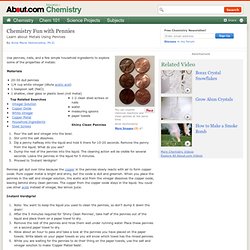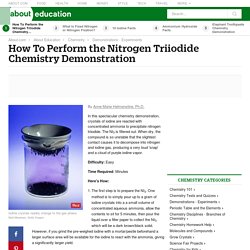

Luminol Chemiluminescence Test for Blood. By Anne Marie Helmenstine, Ph.D.

Updated April 07, 2015. The luminol chemiluminescence reaction is responsible for the glow of lightsticks. The reaction is used by criminalists to detect traces of blood at crime scenes. In this test, luminol powder (C8H7O3N3) is mixed with hydrogen peroxide (H2O2) and a hydroxide (e.g., KOH) in a spray bottle. The luminol solution is sprayed where blood might be found. Only a tiny amount of iron is required to catalyze the reaction. Luminol Materials luminol stock solution (2 g luminol + 15 g potassium hydroxide + 250 mL water)3% hydrogen peroxide in water (common over-the-counter concentration)potassium ferricyanide or a sterile blood lancet and sterile alcohol pad Performing the Test or Demonstration In a clear test tube or cup, mix 10 ml of the luminol solution and 10 ml of the peroxide solution. continue reading below our video Loaded: 0% Progress: 0% Notes About the Luminol Test How the Luminol Test Works.
Luminol Chemiluminescence Test for Blood. Endothermic Reactions Demonstration. Make Disappearing Ink. How to Make a Cloud in a Bottle - Science Demonstration. Here's a quick and easy science project you can do: make a cloud inside a bottle.

Clouds form when water vapor forms tiny visible droplets. This results from cooling the vapor. It helps to provide particles around which the water can liquefy. In this project, we'll use smoke to help form a cloud. Cloud in a Bottle Materials 1-liter bottle warm water match Let's Make Clouds Pour just enough warm water in the bottle to cover the bottom of the container. Ok, here's the ideal gas law: PV = nRT, where P is pressure, V is volume, n is number of moles, R is a constant, and T is temperature. If we're not changing the amount of gas (as in a closed container) then if you raise the pressure, the only way for the temperature of the gas to be unchanged is by decreasing the container volume proportionally. How Clouds Form Molecules of water vapor will bounce around like molecules of other gases unless you give them a reason to stick together. Chemistry Fun with Pennies. Use pennies, nails, and a few simple household ingredients to explore some of the properties of metals: Materials 20-30 dull pennies 1/4 cup white vinegar (dilute acetic acid) 1 teaspoon salt (NaCl) 1 shallow, clear glass or plastic bowl (not metal) 1-2 clean steel screws or nails water measuring spoons paper towels Shiny Clean Pennies Pour the salt and vinegar into the bowl.

Stir until the salt dissolves. Pennies get dull over time because the copper in the pennies slowly reacts with air to form copper oxide. Instant Verdigris! Note: You want to keep the liquid you used to clean the pennies, so don't dump it down the drain! Rinsing the pennies with water stops the reaction between the salt/vinegar and the pennies.
Copper Plated Nails Place a nail or screw so that it is half in and half out of the solution you used to clean the pennies. The copper that coats the nail/screw comes from the pennies. Design Your Own Experiments with Pennies More Projects To Try. Nitrogen Triiodide Chemistry Demonstration. By Anne Marie Helmenstine, Ph.D.

In this spectacular chemistry demonstration, crystals of iodine are reacted with concentrated ammonia to precipitate nitrogen triiodide. The NI3 is filtered out. When dry, the compound is so unstable that the slightest contact causes it to decompose into nitrogen and iodine gas, producing a very loud 'snap' and a cloud of purple iodine vapor. Difficulty: Easy Time Required: Minutes Here's How: The first step is to prepare the NI3.